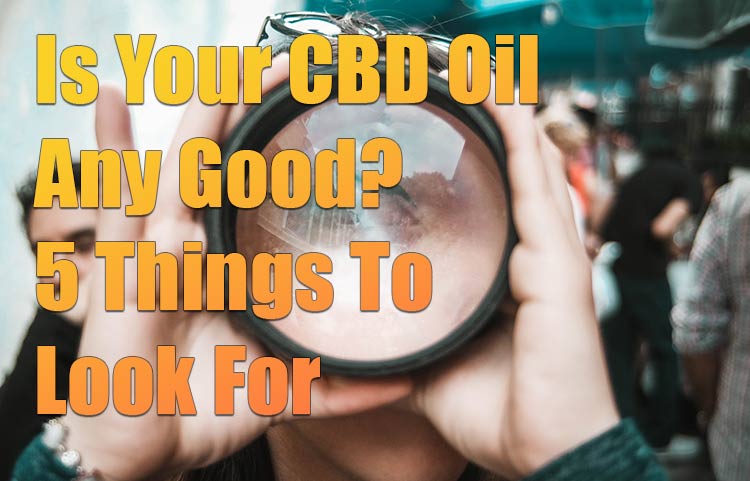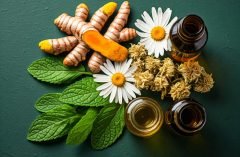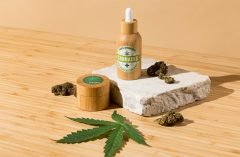Table of Contents [show]
Buying CBD oil in an industry that’s full of competition can be quite challenging. That’s whycit’s so important to pay close attention to your CBD oil’s color, consistency, and the brand you’re buying from. You don’t want just any old CBD oil from the grocery store shelf!
If you’re new to CBD or just unsure whether or not your CBD is actually of a high-quality variety, we’ve got five tips to help you identify your CBD oil’s quality. These tips can be applied to any brand or variety, and will save you money in the long run!
Here are five things to look for in your CBD oil.
1. Broad or Full-Spectrum Oil?
The first thing to know about CBD oil is that it’s not all THC-free. You’ll want to know the difference between broad and full-spectrum oils, so as to avoid THC, which is both psychoactive and creates a “high” and is still illegal according to federal law.
Full-spectrum oils contain the full spectrum of Cannabinoids present in Cannabis Sativa, including THC. Sure, you’ll be getting some CBD as well, but THC will present and presents the risk of causing psychoactive effects. Not to mention, you can’t fly with CBD oil that contains THC.
You’re probably wondering how THC-infused oil even exists if it’s illegal. This is because several states have legalized all forms of Cannabis at the state level, which is actually different from federal law.
That being said, even in states where it’s legal, federal law does not recognize nor protect marijuana/THC. The bottom line? It’s still a Schedule 1 Drug and a crime to possess it.
Broad-spectrum oils will contain many cannabinoids, including CBD, but will not contain any THC. Hemp, from which CBD is extracted, is known to contain high concentrations of the compound while yielding low concentrations of THC.
The federal government requires that hemp contain 0.3 THC or less in order to be considered legal industrial hemp. Most CBD oil producers make CBD oil that contains 0% THC; extracting all traces of the compound.
Penguin CBD is among the brands, containing 0% THC, and offering five flavors to choose from! You can get yours today for just $45 per bottle on the company’s website.
2. Where The Hemp Is Grown
Domestically-grown organic hemp is the source of choice for many of the industry’s leaders. Hemp is a bioaccumulator, which means it is able to absorb chemicals and substances from the soil around it. When hemp is grown in polluted soil, it tends to soak up pesticides, pollutants, and other harmful chemicals that end up in the final product: your CBD oil.
This is why having strict laws about how, where, and when hemp is grown is important, and the US guidelines are some of the most stringent. This ensures the quality of the hemp, and thus, the quality of any products that are created from it. For the full US guidelines, go here.
Organic hemp can be more expensive than imported hemp, and many startups will begin by using imported hemp. This puts the customer at risk not only for contaminated products but often, smaller CBD suppliers don’t have the right extraction supplies, which can lead to higher levels of THC in their CBD oils.
Always check your CBD oil’s label and see if the hemp is grown in the USA. If it’s not proudly displayed on the label, check the company’s website to see where they’re sourcing their hemp from.
3. Color
One quick way to get a better idea of the quality of your hemp oil is to look at its color. What color should CBD oil be? That largely depends on the type of oil and the extraction method used.
Type of Oil: Full and broad-spectrum oils will differ in color because they’ll contain (or lack) certain cannabinoids, terpenes, and plant materials. Color can range from light amber to dark brown, green, or even clear.
Extraction Method: How the CBD is extracted can also affect the color, as well as the carrier oil used for the final product. For instance, coconut oil is pretty much colorless. When ethanol extraction is used, the chlorophyll that gives plants their green color comes too, giving the oil a green color.
4. Price
Price can be a bit touchy because it’s not fair to say that CBD oil that’s priced lower is necessarily bad, but just keep this in mind: higher-quality ingredients, processing and extraction methods, and concentrations of specific cannabinoids will affect the price of your CBD oil.
The $10 bottle you found at your local retail store is probably $10 for a reason, especially when many leading online CBD brands start at around the $20-$30 range, depending on the CBD concentration. Essentially, you’re getting what you pay for.
That being said, even if you find an expensive oil, it’s best to research the brand before committing to buy, as there are plenty of scam companies operating in the industry that charge an arm and a leg for sub-par products.
5. Lab Testing
Any reputable CBD brand will proudly display their “independently lab-tested” seal. This means that every batch has a sample sent to a third-party lab to test quality, consistency, and potency.
This is probably the easiest way to distinguish a good product from a sub-par one. Any company that takes enough pride in their product to have it independently tested is likely producing something of value.
Conclusion
Ensuring the quality of your CBD oil means getting the best possible results and the most value for your money. Following these five easy tips will ensure that you’re only paying for the best CBD oil. Always check the ingredients, whether or not the oil is lab-tested, and research the brand you plan to buy from.
Also, remember that customer reviews can actually tell you a lot about CBD oil and how effective it is. No one knows better how it applies to real-life experience than someone who’s already used it!
Further Reading:
5 Things You Should Know About Using Prescription-Free CBD Products
Will CBD Vaping be Affected by Bans on E-Cigarettes
Does Good CBD Stay in Your System a Long Time?





